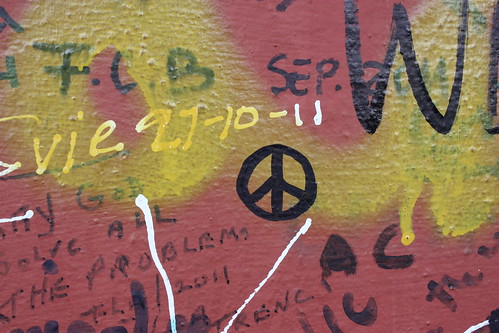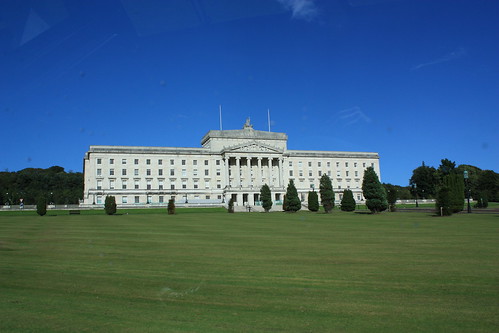The Troubles in Ireland: The Beginning

Stained glass window at Stormont.
–
After my tome about Irish history, I’ve managed to avoid serious discussion or mention of Irish politics for two whole weeks (I consider this an achievement of sorts. Instead, I talked about Halloween costumes and candy). But the hour has arrived. It is time to talk about the Troubles.
Please note that all caveats expressed last time hold true for this post. Parts of it will be biased, and parts of it will be inaccurate. I am not a historian. I didn’t even do that well in history class in school. I’m struggling to understand most of this myself.
And with that disclaimer, here we go, once again …
“The Troubles” is the rather innocuous-sounding phrase used to describe the internal conflict that continued in Northern Ireland long after the Republic had been established. I’m guessing they went with “The Troubles” because it sounds infinitely more poetic than “The Bloodbath” or “The Really Long Guerrilla War” or “The 40 Years We Spent Throwing Molotov Cocktails at Our Neighbors” (all of which would have been a bit more accurate.)
At the heart of the Troubles is the same old conflict that plagued Ireland for centuries – the one between Catholics and Protestants.
As I mentioned earlier, there are two entities on the island of Ireland: Northern Ireland, and the Republic of Ireland. Northern Ireland consists of the six counties, populated largely by Protestants, that had voted to remain part of the United Kingdom. The rest of Ireland (which was predominately Catholic) became the Republic of Ireland – a free and independent sovereign.
Not everyone was happy with this agreement. The “relinquishing” of the six countries to the north led to the Irish Civil War in the Republic. (In the meantime, many folks in Northern Ireland watched the fighting to the south and became even more strengthened in their resolve to want no part of the new country).
After the Civil War ended, one would hope that things would be calm on the island. The lines were drawn, right? Protestants Unionists on one side, Catholic Nationalists on the other.
But things were not nearly that simple. Not everyone in Northern Ireland was a Unionist. Unionists may have been the majority (and the MPs’ votes in Parliament reflected that) but there were still plenty of Nationalists in the North (about a third of the population was Catholic).

Peace is going to take a while.
–
The Nationalists still hoped for a United Ireland – that the entire island – all 32 counties – could form one independent country (though a select few wanted Northern Ireland to be its own independent country). They felt the northern counties were under occupation by the United Kingdom. The Unionists, on the other hand, identified as British – and felt that the Nationalists were disloyal and had no business remaining in Northern Ireland if they didn’t want to be part of Great Britain.
The Unionists were two-thirds of the population, but they held even more clout in Parliament due to gerrymandering (district lines were drawn to favor them and disenfranchise Nationalists). A number of anti-Catholic laws that had remained on the books from the century before were still being enforced; workplaces could discriminate against and refuse to hire Catholics; Catholic areas were offered less governmental support and financing, and received less access to public housing than their Protestant counterparts.
That last issue is an important one; being a homeowner was directly tied to being able to vote in local elections. If you owned property in more than one district, you were even allowed more votes. Up to six per person. (This makes my head kind of spin. It reminds me of a quote I heard on a recent episode of 30 Rock from Jack Donaghy: “New York will go for Obama, even if I voted a hundred times. Instead of my usual five.”) So if Nationalist Catholics weren’t granted public housing, they wouldn’t be able to vote (at least, not as much as their Protestant counterparts).
By the 1960s, many Nationalists felt that their Civil Rights were being compromised; inspired by the Civil Rights Movement that was happening over here in the states, they began to campaign and peacefully (at the beginning, at least) protest. By 1967, the NICRA (The Northern Ireland Civil Rights Association) had formed.
The NICRA held a series of Civil Rights marches which helped to unify Catholics throughout Northern Ireland, and drew worldwide attention to their cause. The organization called for an end to several injustices – among them, the weighted voting system that favored Unionists, and the unfair allocation of council (a.k.a., public) housing.

Modern day council houses in a Protestant/Unionist neighborhood in Belfast.
–
While the Catholic Nationalists had the NICRA, the Protestants also had a number of organizations that were marching on their behalf, including the Orange Order and the Apprentice Boys of Derry (note: “boys” is merely a colloquialism. They were full-grown men). Interestingly, parades became a huge issue (again, this one kind of makes my head spin, as parades here in the states tend to be jovial affairs that involve giant balloons and inane banter from whoever is hosting the event on T.V. – usually Ryan Seacrest.) But when you consider the history of these opposing factions – how this conflict had literally been going on FOR CENTURIES – it becomes easier to fathom. Organizations were plotting parade routes to run through neighborhoods populated by their opposition. They chose dates that had historical significance (commemorating past battles or anniversaries when one side defeated the other). Tensions were rising.
There’s much debate over when, precisely, the Troubles began, but there are two important events, each of which are often cited as the beginning of the conflict: the Derry March, and the Battle of Bogside.
The Derry March refers to a Civil Rights march (a.k.a, a Catholic, Nationalist march) that was set to go through the town of Derry – also known as Londonderry – on October 5, 1968. (Note: Even the name of the town was a point of contention. The Nationalists called the town Derry, the Unionists called it Londonderry. If you want to know more about this issue, Wikipedia does a decent job explaining it. But the significance is this: everything, even city names were heated topics in Northern Ireland in the 20th century).
A few days prior to the march, the Protestant Apprentice Boys of Derry declared that they would be having their annual parade on precisely the same day, on precisely the same route as the Civil Rights March. Uh-oh.
As a response, William Craig, the Home Affairs Minister (who later argued that the Civil Rights organizations were just a front for the militant Nationalist group known as the IRA), declared a ban on all Civil Rights marches. This did not include The Apprentice Boys of Derry (theirs was not a Civil Rights march), who were free to continue with their parade.
In defiance of the ban, the Nationalists also continued with their Civil Rights march. They were met by the Royal Ulster Constabulary (the RUC) – the police force in Northern Ireland at the time. The force was roughly 90% Protestant.
The marchers quickly dispersed when they came under attack from the RUC. Here’s a snippet of the BBC news report from that day (note that they call the town Londonderry):
Violent skirmishes broke out and very quickly the street was filled with police wielding batons against men, women and children.
When video of the violence and photos of what had happened emerged, Nationalists were outraged. Days of rioting in Derry ensued. By November of that year, in response to the violence, rioting, and public sit-ins that had rocked the region for the past few months, the British Prime Minister issued a list of reform measures which included distributing council housing based on need (meaning more Catholics would have homes), and abolishing the system that gave wealthier Protestant landowners more than one vote.
In response, several Nationalist groups halted their marches temporarily. But tensions continued to rise, and there were more and more violent exchanges between the opposing factions. The reforms had been too little, too late.
Nearly a year after the Derry March, in the summer of 1969, the Battle of Bogside took place.
The Apprentice Boys of Derry were once again marching, this time in the predominately Catholic town of Bogside. The march itself was to commemorate a Protestant victory over Catholics (back in the 1600s), and was, by its very nature, considered highly contentious. Nationalists arrived to protest the parade. Verbal altercations soon led to physical violence and the result was a three-day long citywide riot.
The RUC was unable to contain the riot, and eventually British forces had to be called in to relieve them. The Battle of Bogside triggered other riots throughout the country.
The Troubles were now most certainly upon Northern Ireland.
Around this time, there were paramilitary groups on both sides of the conflict. I noted that after the Easter Rising (back in the 1920s), the Irish Republican Army – a militant Nationalist group known for violent tactics – had emerged. The IRA had mostly become inactive by the 1960s, but after the Battle of Bogside, a group calling itself the Provisional Irish Republican Army appeared.
The PIRA was not opposed to using violence to achieve their goals of a united Ireland.
There were also violent Unionist groups on the other side of the conflict (let me make one thing clear: none of these violent paramilitary groups spoke for the entire populace. There were people who were sick of the fighting and warring on both sides, who condemned it all. The problem was that the bombs and the attacks got press – that’s what people heard about). The Ulster Volunteer Force was perhaps the most visible. In Belfast, there remain a lot of murals depicting UVF soldiers, who were known for wearing balaclavas to cover their faces.

Mural in a Protestant community in Belfast.
–
In 1972, Bloody Sunday occurred (yes, that’s what Bono was singing about a decade later). During a peaceful demonstration in Bogside, British police fired at the crowds, killing 14 people (the police had been told that IRA snipers were present). They claimed that the group was armed, but no guns were recovered, and many of the victims were shot in the back, as they were fleeing from police. The events legitimized the IRA’s presence; they argued that Catholics needed to use force.
From the 1920s (after the Irish Civil War had ended) to the 1970s, Northern Ireland had its own parliament (known as Stormont), but shortly after Bloody Sunday, it was disbanded. The region was now directly under British Rule.

Stormont, in Belfast.
–
Aaaand, you know what? I think that’s where I’m going to stop for today. Later this week, I’ll discuss how the Troubles continued through the 80s and 90s, the impression that we had of them here in the states, as well as Sinn Fein (the political branch of the IRA), and talk about how ultimately (more or less) peace was attained.
But right now? I need another whiskey.









Leave a Comment